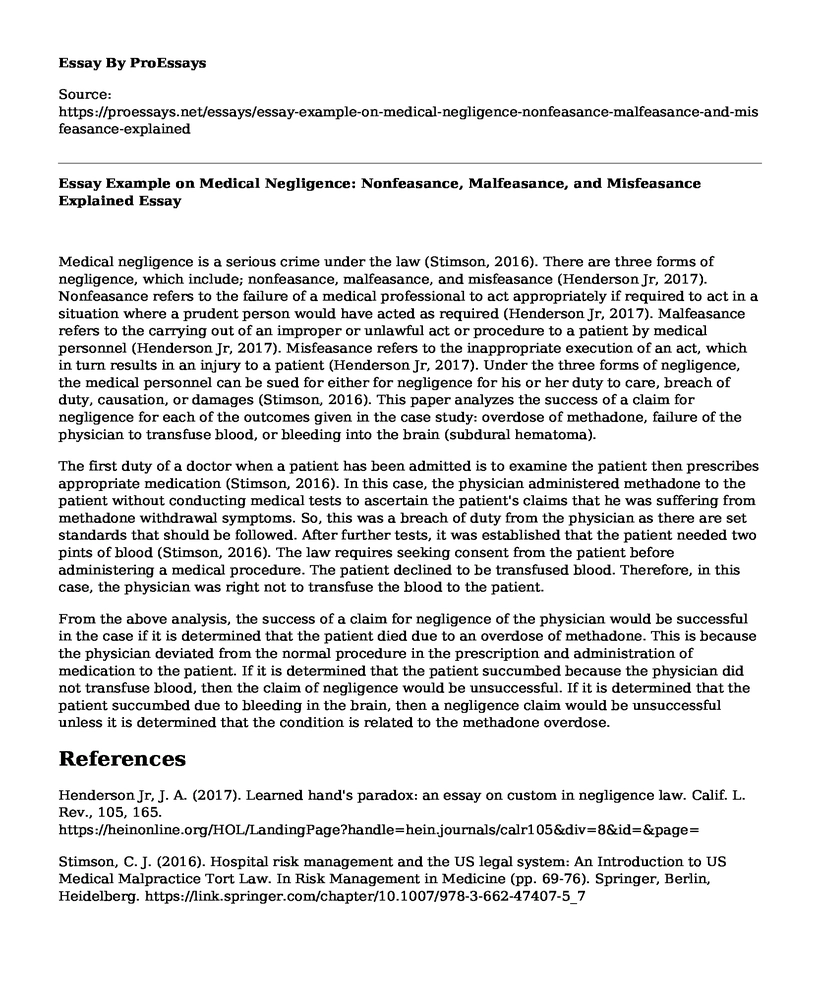Medical negligence is a serious crime under the law (Stimson, 2016). There are three forms of negligence, which include; nonfeasance, malfeasance, and misfeasance (Henderson Jr, 2017). Nonfeasance refers to the failure of a medical professional to act appropriately if required to act in a situation where a prudent person would have acted as required (Henderson Jr, 2017). Malfeasance refers to the carrying out of an improper or unlawful act or procedure to a patient by medical personnel (Henderson Jr, 2017). Misfeasance refers to the inappropriate execution of an act, which in turn results in an injury to a patient (Henderson Jr, 2017). Under the three forms of negligence, the medical personnel can be sued for either for negligence for his or her duty to care, breach of duty, causation, or damages (Stimson, 2016). This paper analyzes the success of a claim for negligence for each of the outcomes given in the case study: overdose of methadone, failure of the physician to transfuse blood, or bleeding into the brain (subdural hematoma).
The first duty of a doctor when a patient has been admitted is to examine the patient then prescribes appropriate medication (Stimson, 2016). In this case, the physician administered methadone to the patient without conducting medical tests to ascertain the patient's claims that he was suffering from methadone withdrawal symptoms. So, this was a breach of duty from the physician as there are set standards that should be followed. After further tests, it was established that the patient needed two pints of blood (Stimson, 2016). The law requires seeking consent from the patient before administering a medical procedure. The patient declined to be transfused blood. Therefore, in this case, the physician was right not to transfuse the blood to the patient.
From the above analysis, the success of a claim for negligence of the physician would be successful in the case if it is determined that the patient died due to an overdose of methadone. This is because the physician deviated from the normal procedure in the prescription and administration of medication to the patient. If it is determined that the patient succumbed because the physician did not transfuse blood, then the claim of negligence would be unsuccessful. If it is determined that the patient succumbed due to bleeding in the brain, then a negligence claim would be unsuccessful unless it is determined that the condition is related to the methadone overdose.
References
Henderson Jr, J. A. (2017). Learned hand's paradox: an essay on custom in negligence law. Calif. L. Rev., 105, 165. https://heinonline.org/HOL/LandingPage?handle=hein.journals/calr105&div=8&id=&page=
Stimson, C. J. (2016). Hospital risk management and the US legal system: An Introduction to US Medical Malpractice Tort Law. In Risk Management in Medicine (pp. 69-76). Springer, Berlin, Heidelberg. https://link.springer.com/chapter/10.1007/978-3-662-47407-5_7
Cite this page
Essay Example on Medical Negligence: Nonfeasance, Malfeasance, and Misfeasance Explained. (2023, Aug 12). Retrieved from https://proessays.net/essays/essay-example-on-medical-negligence-nonfeasance-malfeasance-and-misfeasance-explained
If you are the original author of this essay and no longer wish to have it published on the ProEssays website, please click below to request its removal:
- Food Security Theories
- Research Paper on Obesity in Children, Michigan
- Effective Learning Program for Healthcare Practitioners: Addressing the Challenges of Opioid Treatment at SAMC
- Essay on Concussion: Biomechanically Induced Clinical Syndrome
- Essay Sample on Child Anemia: Causes, Symptoms & Treatment
- Ethical Conflicts in the Medical Field - Essay Sample
- COVID-19 and Prison System - Report Example







